Tamiya 1/48 Avro “Type 464 (Provisioning)” – 100th Anniversary of the RAF Group Build
Little needs to be said about the Lancaster, one of the truly legendary “greats” of the Second World War. A product of brilliant improvisation when the twin-engine Manchester proved underpowered and unreliable, Avro took the airframe and provided a wing extension to allow four Merlins to b e used for power. The Lancaster became the backbone of Bomber Command and proved itself to have a back that couldn't be broken as it carried bomb loads no other bomber of the war came close to.
For the famous Dams Raid, known as “Operation Chastise,” a specially adapted version of the Lancaster, the B.III (Special), officially the "Type 464 (Provisioning)" was created. The bomb bay doors were removed and the ends of the bay were covered with fairings. The weapon, known as “Upkeep,” was suspended on pivoted, vee-shaped struts which sprang apart when the bomb-release button was pressed. A drive belt and pulley to rotate the bomb at 500 rpm was mounted on the starboard strut and driven by a hydraulic motor housed in the forward fairing. The mid-upper turret was removed and a more bulbous bomb aimer's blister was fitted. The first adapted aircraft arrived at Scampton on 8 April, 1943.
David Maltby: the Pilot who broke the Möhne Dam:
David Maltby was born on 10 May 1920 in Baldslow, outside Hastings, Sussex, where his father was a headmaster at Hydneye House school, which he attended before leaving to join Marlborough College between 1934 and 1936. He entered training as a mining engineer in Trenton, South Yorkshire in 1938, but resigned at the outbreak of war. When he volunteered to join the Royal Air Force (RAF) in 1939, he was told to wait. Eventually he was called up on 20 June 1940 and formally joined the RAF Reserves after being accepted for aircrew training.
Maltby was assigned to 106 Squadron in June 1941, where he flew the Handley-Page Hampden on five operations before being transferred in July to 97 Squadron, where he first flew Hampdens, then Avro Manchesters and finally Lancasters. Having been promoted to Flight Lieutenant, upon completing his first tour in June 1942, he was awarded the DFC on 11 August 1942.
After six months commanding an Air Bomber Training Section in 1485 Target Towing and Gunnery Flight, he returned to 97 Squadron in March 1943 where he was assigned a new crew, most of whom had only just finished training. On 25 March 1943, he and his crew were transferred to 617 Squadron, along with Flight Lieutenants Joe McCarthy and Les Munro and their crews.
Maltby flew Lancaster “J-Johnny,” as part of the first wave that attacked the Möhne Dam. “A-Apple,” flown by “Dinghy” Young hit the dam and caused a small breach that was not apparent from the air, “J-Johnny” then attacked and scored a hit that caused a large breach. For his part in the operation, Maltby was awarded a DSO and then shortly after promoted to Squadron Leader as a flight commander.
David Maltby and his crew were killed on 16 October 1943 during “Operation Garlic,” a failed attempt by 617 Squadron at a low-level raid on the Dortmund-Ems Canal. After the mission was cancelled due to fog over the target, Maltby's Lancaster (JA981) crashed into the North Sea while returning to base as the result of a collision with a 139 Squadron Mosquito (DZ598) flown by Flight Lieutenant M. W. Colledge with navigator Flying Officer G. L. Marshall, who were returning from a mission to Berlin. The Mosquito was northeast of Cromer on a course for Wyton, when it intersected Maltby's course to Coningsby. Dave Shannon, a fellow dambuster, circled the crash site for two hours waiting for rescue that never arrived. Maltby's body was washed ashore the next day, the only crewmember recovered. After being identified by his 18 year old sister, he was buried in the churchyard of St. Andrew's Church, Wickhambreaux, Kent.
Charles Foster, nephew of David Maltby, wrote “Breaking the Dams: The Story of Dambuster David Maltby and His Crew”, published in 2008. I found it to be a good inspiration for the model I built here.
The Dams Raid:
On the evening of May 16, 1943, Wing Commander Guy Gibson was driven out to his aircraft “G-George” by his regular driver, Eileen Strawson. 5 Group commander Air Vice Marshal Sir Ralph Cochrane came out to the aircraft to wish them well, and a photo was taken of the crew entering the aircraft.
Gibson took off at 2139 with “Hoppy” Hopgood and “Mickey” Martin. They flew out over Skegness and Cromer and found the winds stronger than forecast, which resulted in making landfall later and further south than expected, entering continental Europe between Walcheren and Schouwen. They flew over the Netherlands, skirted the airbases at Gilze-Rijen and Eindhoven, curved around the Ruhr defenses, and turned north to avoid Hamm before turning south to head for the Möhne River. Dinghy Young with Les Munro and David Maltby flew further north, cutting over Vlieland and crossing the Isselmeer before joining the first route near Wesel and then flying south beyond the Möhne to the Sorpe River. On the way, Les Munro's Lancaster took a hit and lost its radio; he was forced to abort.
Formation Two ran into trouble: Rice flew too low and struck the sea, losing his bomb in the water; he recovered and returned to base. Barlow and Byers crossed the coast around Texel. Minutes later, Byers was shot down by flak and crashed into the Waddenzee. Barlow hit electrical pylons and crashed 5 kilometers east of Rees, where the bomb was thrown clear of the crash to be later examined intact by Heinz Schweizer. Only McCarthy's delayed bomber survived the Netherlands crossing. Formation One lost Astell near the German hamlet of Marbeck when he flew his Lancaster into high voltage electrical cables and crashed in a field.
The bombers flew at about 100 feet to avoid radar detection. Flight Sergeant George Chalmers, radio operator in Flight Lieutenant Thompson's "O for Orange", looked out through the astrodome and was astonished to realize his pilot was flying towards the target along a forest firebreak, below treetop level.
On arrival at the Möhne Dam, Gibson found the defenses as had been described, with an active light flak battery but no searchlights or barrage balloons. He made a dummy run to look the target over and reported how he "liked the look of it". Dinghy Young and David Maltby arrived at this point. Gibson made his bomb run but released short without damaging the dam. It took about five minutes for the water to settle down after the explosion.
He then called in Hopgood and watched as “M-Mother” was hit by flak, caught fire and then exploded. Hopgood had managed to release the bomb but it overshot and destroyed an electrical station below the dam. Three crew members successfully abandoned the aircraft, but only two survived.
Gibson waited again for the water to settle, then called in Mickey Martin in “P-Popsie” but this time he decided to fly with the attacker, parallel and slightly ahead, to draw off the flak. Martin's drop was ineffective.
Gibson then called in Young; Martin flew alongside while Gibson flew along another evasive path. Young's bomb hit the dam but the results were not obvious until Maltby started his run and saw a crack in the dam. Maltby's bomb hit nearly at the same place as Young's and the dam was completely breached. At 0056 on 17 May, Gibson's radioman Flight Sergeant Hutchinson sent the code word, the name of Gibson's recently killed dog, to signal the breach to 5 Group and then confirmed it on their request. Mickey Martin and David Maltby departed for home while Gibson, with Young accompanying, led Shannon, Maudslay and Knight to the Eder Dam.
The Eder Valley was covered by heavy fog but the dam was not defended. The surrounding hills made the approach difficult and Dave Shannon made six runs before taking a break. Maudslay in "Z- Zebra" made a drop but the bomb struck the top of the dam and the aircraft was severely damaged in the blast. Shannon made a seventh run and successfully dropped his bomb. Les Knight's "N-Nut," breached the dam.
The Sorpe dam was least likely to be breached, being made of earth. Only McCarthy in "T for Tommy" and Brown in "F for Freddie" managed to attack the dam. In this attack, the bomb was not spun, and the approach was made along the length of the dam. None were able to attack successfully.
McCarthy finally arrived over the Sorpe at 0015. hours, and realized the approach was even more difficult than expected. He made nine runs before bomb aimer George Johnson was satisfied and dropped on the tenth. The bomb exploded but when McCarthy assessed the damage, it turned out only a section of the crest of the dam had been blown off.
After seven runs in increasingly dense fog, Brown dropped incendiaries on either side of the valley, which started a fire that lifted the fog enough to get a direct hit on the eighth run, cracking but failing to breach the dam.
During the return flight over the Dutch coast, some flak was aimed so low that shells were seen to bounce off the sea by the survivors and two more Lancasters were lost. Maudslay's aircraft was struck by flak near Netterden, and “Dinghy” Young's "A-Apple" was hit by flak north of Ijmuiden and crashed into the North Sea just off the coast of the Netherlands; this time the redoubtable pilot who had survived three shoot-downs was never found.
Maltby was the first of 11 Lancasters that began landing at Scampton at 0311 hours on May 17. Gibson landed at 0415. Townsend's “O-Orange” landed at 0615, the last to return because one of its engines had been shut down after passing the Dutch coast. Air Chief Marshal Harris was among those who came out to greet the last crew to land. With Townsend's return, the full extent of the losses – eight aircraft and 56 crew – became apparent.
Bomb designer Barnes Wallis was distraught when he learned the human cost, “What have I done that I have caused these young men to be sent to their deaths?” Gibson told him that no crew ever went on a mission without the thought they might not return. Johnny Johnson, who knew Wallis in his later years, related that the designer never forgave himself for the losses, and dedicated his development of the Tallboy and Grand Slam bombs to the hope they would end the death and destruction of the war sooner.
The Dams Raid, the most daring mission ever flown by the RAF other than the Vulcan mission to the
Falklands in 1981, is considered to be Bomber Command's finest hour. 617 Squadron remains in service to this day, known forever after as “The Dambusters.”
Guy Gibson:
It is interesting to note that the Guy Gibson known to popular history is not the man known to the men he flew with and who served under him. In fact, the real man was 180 degrees from the character created by RAF wartime propaganda, then cemented in the popular imagination by Paul Brickhill's book, “the Dambusters,” and by the portrayal of Gibson by Richard Todd in the motion picture of the same name.
The more accurate portrait of Gibson was first revealed by British historian Sir Max Hastings in “Warriors: Portraits From The Battlefield,” published in 2005. Interestingly, the real Gibson had been visible for some 50 years at that point, at least to those who read Johnny Johnson's autobiography “Wing Leader,” in which the RAF's leading ace recounted a not-so-pleasant encounter with Gibson in a station officer's club. Additionally, the two surviving 617 aircrew who were interviewed for the BBC (broadcast in the US by PBS) series “Secrets of the Dead” in the early 1990s were non-committal about their leader, with one describing him as “a typical pissy little English public schoolboy.”
Guy Gibson is indeed an unlikely hero, with a messy private life and a far from friendly relationship with his colleagues and subordinates. As with many similar men, the roots of both his greatness and his darkness can be traced to the traumas and challenges of his childhood.
Born in August 1918 in Simla, India, his father Alexander worked for the Imperial Indian Forestry Service. While Alexander's job gave the family a decent lifestyle, complete with servants, Gibson's parents' marriage was terribly dysfunctional.
Gibson's father was abusive in the most corrosive way; on the first night of his honeymoon, he forced his wife Leonora to watch him have sex with a prostitute so she could learn what he required of her. He would later forcibly sexually initiate his daughter.
Guy was the third and last child. By then his mother was desperately unhappy and descended into alcoholism from which she never recovered. Divorcing Alexander, she returned to England with her children. While she managed to get the boys into the same “minor public school” that Douglas Bader had attended, their home life became increasingly difficult. One night, the three children were awakened by their mother brandishing a knife and yelling at them to get out. They did so, hiding in a field. The toughness Guy developed during such a difficult childhood meant he had the perfect temperament for wartime heroics.
After joining the RAF on a short service commission in 1936 in order to gain experience to become a test pilot, Gibson's initial posting was to 83 Squadron at RAF Turnhouse, west of Edinburgh. The Squadron was flying Hawker Hinds. He joined a settled group of officers from similar minor public school backgrounds. Promotion was slow, since many pilots stayed with the squadron for a few years,. Finally, he was promoted to pilot officer on 16 November 1937. Throughout his time on the squadron, his relationship with the enlisted ground crews continued to be perceived as unsatisfactory; he received the nickname "Bumptious B a s t a rd" from them, a indication of his future relations with men he would lead and command.
83 was transferred in March 1938 from 2 Group to 5 Group and relocated to RAF Scampton. In October, the squadron began conversion to the Handley Page Hampden, which was completed by January 1939.
Gibson was set to fly the first Bomber Command mission of the war, to attack the German fleet at Wilhelmshaven on 3 September, the first day of the war for Britain, but the mission was canceled for bad weather. They did not fly a further mission during the “Phoney War” until December and had only flown five by the time the war changed in April. Between April to September 1940, Gibson flew 34 missions in five months, with 10 in June. During this period, he acquired a reputation for being seemingly fearless, particularly as he was willing to fly in marginal weather and became known as a “press-on type”; throughout the war, most crews intensely disliked pilots with this label, since they saw these men as most likely to be the death of the crew.
Gibson was awarded the Distinguished Flying Cross on 9 July 1940. He missed a low-level attack on the Dortmund-Ems canal on 12 August. Returning from a raid on Lorient on 27 August 1940, he spotted a Do-215 and was credited with a "probable" kill, a most unlikely event for a Hampden pilot. On 3 September 1940 he was promoted to Flight Lieutenant, and his final operation with the squadron was a mission to Berlin on 23 September. Air Vice Marshal Arthur Harris, then the AOC of 5 Group, later described Gibson as the "most full-out fighting pilot" under his command.
While Gibson was earning the respect of his superiors, he also gained a reputation for being something of a bully, frequently publicly berating ground crew for perceived shortcomings; at one point he threatened to bust a corporal to ranks for failing to salute him.
That fall, Gibson was transferred to Fighter Command, where he flew in 29 Squadron during that unit's transition from the Blenheim IV(F) to the Beaufighter I, gaining experience in night operations.
Following this tour, Gibson was due to be posted to 51 OTU,as Chief Flying Instructor. He had decided he wanted to return to bombers. His opportunity to get out of Fighter Command came a few weeks later when, on 22 February 1942, Arthur Harris was appointed Air Officer Commanding-in-Chief of Bomber Command. On 22 March, Harris wrote to Air Vice Marshal John Slessor, AOC 5 Group, of his intention to promote Gibson to acting wing commander to put him in command of a Lancaster squadron. Gibson was mad OC 106 Squadron, flying Manchesters.
At 106, squadron morale was going down as a result of the disappointment with the Manchester due to the unreliability of its Rolls Royce Vulture engines. Gibson set a favorable opinion when he only flew the difficult missions. In April 1942, 106 flew on eighteen nights, six consecutively; the improvements in performance under Gibson were noted by analysts at both 5 Group and Bomber Command.[Lancasters finally arrived in May; Gibson made his first flight in one shortly after.
As commander, Gibson's main concern was to be seen to share the risk.He continued to fly the harder targets and expected the same determination from everyone on the squadron. He was ruthless in screening crews for reliability, with 106 having the highest LMF (Lack of Moral Fibre) dismissals of any squadron in Bomber Command. Crews respected him and hated him at the same time. He developed a reputation for being prone to unreasonable outbursts and the persecution of some crews and their members.
Gibson's time at 106 saw the emergence of an inner circle of officers who shared his intensity for operations. Their off-duty activities included swimming, water polo and shooting. However, his behavior towards NCOs and ground crews was still a problem. It did not take long for the NCO pilots and aircrew to perceive him as particularly high-handed in his treatment of enlisted men; the ground crews quickly gave him the nickname "The Boy Emperor"
According to the mythology of the RAF and Brickhill's book, Gibson's crew volunteered to a man once they were off operations to move to 617 with him. In reality, only his radioman, Flight Sergeant Hutchinson, came with him to the new squadron. The others considered themselves lucky to be well rid of him.
Following the Dams Raid, Gibson was seen as too valuable in terms of his propaganda value to be allowed to fly. He toured the U.S. and Britain and was retired from active operations by his superiors. After a great deal of pleading, Gibson was allowed to fly “in anger” in late 1944.
On the night of September 19, 1944, he took the assignment of Master Bomber to lead 227 Lancasters and ten Mosquito pathfinders on a mission to bomb Rheydt and Munchen-Gladbach in Germany. He crashed and was killed during his return flight.
Aviation historians ever since have always been skeptical of the RAF's official cause of the crash. Two theories were forwarded: the first that Gibson ran out of fuel and crashed; critics countered that Gibson was too skilled a pilot, and that since he could fly a Lancaster at low heights, he was certainly skilled enough to glide a Mosquito to a decent crash landing. The second cause was that Gibson was flying his Mosquito very low and was hit by enemy ground fire.
In October 2011, newly-found evidence indicated very clearly that Gibson was brought down by “friendly fire” when a Lancaster mistook Gibson's low-flying Mosquito as a Luftwaffe night fighter and shot at it accordingly.
Lancaster tail gunner Sergeant Bernard McCormack believed that he mistook Gibson's Mosquito for a Ju-88. His Lancaster was returning from a night raid; he saw a twin engine aircraft with a single rudder come up behind his aircraft, and opened fire. The aircraft disappeared and on his return to base he claimed a Ju-88 night fighter shot down. The next day, the crew were queried by high-ranking RAF officers; when he described his “Ju-88,” it was pointed out to him that the Mosquito had the same look. Nothing more was done, but McCormack became convinced he had shot down Gibson's Mosquito. He died in 1992 but not before he recorded what he believed had happened. In 2011, his wife provided the tape recording to a British aviation historian.
The official RAF report stated that no other aircraft was in the vicinity of Gibson's Mosquito when he crashed, which led to the guesses he had run out of fuel or been shot down by ground fire. However, the combat report of McCormack's Lancaster clearly shows the aircraft was in the vicinity where Gibson would have been flying. Another Lancaster crew flying in the same area also noted in their combat report that they saw an aircraft flying out of control before crashing. Both crews saw red target indicator flares explode in the crashed aircraft and Gibson's Mosquito had been carrying the very same flares, which he had not used because of an equipment malfunction.
If this is the case, it is understandable why the RAF would want the loss of their greatest hero of the war in such an incident covered up. "Killed in action" by the enemy was a more acceptable reason to explain away Gibson's death and would have fitted with his hero status. “Killed by your own side” would have been a propaganda disaster.
As an historian and a writer of dramatic fiction, as well as a service veteran, I find the real Guy Gibson extremely interesting, far moreso than the manufactured “hero.” A man like Richard Todd (who as a British paratrooper took part in the taking of Pegasus Bridge during the Normandy invasion) is easy to like and respect, and to want to follow. How did a man so many disliked so intensely, a man with so many personal failings, manage to attract men like Mickey Martin, Dinghy Young, Les Munro and the other Bomber Command aces who came to 617 when he asked them? These men had nothing to gain by volunteering; with their multi-tour records, no one would have thought less of them for declining the invitation.
I think it comes down to “birds of a feather, flock together.” All those men were all “press-on types;” they recognized Gibson as a kindred soul, and were willing to forgive his personal failures in light of his professional record. Military history is full of men like Gibson, failures at any civilian activity, who rose to greatness in the crucible of combat. In my own time in the service, I knew a few like Gibson, men I would have run to the other side of “Civvy Street” to avoid, who I thought at the time were men I would have followed into the jaws of hell, had the opportunity presented itself. Guy Gibson was such a warrior.
There are literally 15 pages of books about 617 Squadron and the Dams Raid listed at Amazon, from out-of-print classics to modern studies.
Gibson's personally-written memoir, “Enemy Coast Ahead,” is still one of the best accounts of a pilot in Bomber Command available. Heavily censored by the RAF before it was first published after his death, to remove many personal opinions and preserve the “official portrait” of the heroic leader of the Dams Raid, the best edition of the book for a reader who demands accuracy is the paperback edition “Enemy Coast Ahead - Uncensored: The Real Guy Gibson,” released by Crecy Publishing in 2003. It is Gibson's original manuscript, which was archived and held secret for 60 years. This uncensored edition reveals his true view of the course of the war, of his pilots and crews and Bomber Command tactics. Reading it, it's easy to see why the RAF censored it.
Another excellent book, far more accurate than Brickhill's propaganda account, is James Holland's “Dam Busters: The True Story of the Inventors and Airmen Who Led the Devastating Raid to Smash the German Dams in 1943.” This full and complete account of how the weapon was developed and how the raid was planned and carried out is in my opinion the best book on the subject.
THE KIT
Tamiya first released their 1/48 Lancaster in 1973, and it has been in and out of production ever since. The March 2013 release saw the kit parts in light grey plastic rather than the previous black, with the addition of the later tail turret with two .50 caliber machine guns as used in limited numbers during the war and by all after the war. There is also all three different bombardier's clear domes used during the Lancaster's service. Decals and markings included the white-over-black Lancaster B.III (FE) Lancasters that toured North America in 1948.
I already had the older “Dambuster/Grand Slam” Lancaster kit, which I had picked up at a modeler's estate sale, and decided to build a Dambuster for the 70th anniversary of the Dams Raid in May 2013. With the kit completed to sub-assemblies of fuselage, wings and tail, other things got in the way, including a move to a different house, and the box containing the built-up sub-assemblies and the kit box were consigned to a far corner of the stash, where they were only re-discovered this past May, the 75th anniversary of the raid. With a group-build to commemorate the Centenary of the Royal Air Force going on at iModeler, I decided it was as good a time as any to resurrect the project from the Dungeon of Death. I even found the Xtradecal “617 Squadron” sheet I'd gotten, with the markings for David Maltby's Lancaster in which he broke the Möhne Dam. Since everyone else seems to want to do Guy Gibson's airplane to death, I decided to go with this, the successful dambuster.
CONSTRUCTION
The kit is a product of its time in the 70s, when fit was not what one finds now. Putty is needed on the fuselage centerline seam, while the engine cowlings require lots of putty followed by Mr. Surfacer, with subsequent sanding down and rescribing of detail. Belcher Bits makes a set of resin engine cowlings for this kit that solve all the problems, and if you are going to invest in doing this kit, getting hold of that set is highly recommended. Bear in mind that the raised surface detail on the kit is a far more accurate representation of the surface of a Lancaster than one would get in a modern kit; you don't need to rescribe more surface detail than you sand off.
I had thought of using the Eduard “Big Ed” set and really detailing the model, but I realized as I got into it that outside of the detail in the cockpit, nothing else would be visible when completed. I therefore limited myself to using the photoetch instrument panel, throttle controls, flight engineer's panel and the seatbelts for the seats that can be seen.
I assembled fuselage, wings, and horizontal stabilizers and rudders as separate assemblies that would be brought together after the model was painted.
THE REST
I painted the Dark Earth and Dark Green upper camouflage, then masked that off and painted the rest of the model with Tamiya X-18 “Semi-gloss Black.”
I used the Xtradecals for the markings, and kit decals for the stenciling, wing walks, and trestling guides.
I unmasked the canopy and side windows, then attached the turrets and the carrying frame and the Upkeep. Recent research indicates that the Upkeep was painted in red primer, for which I used Tamiya “Hull Red.” The main gear doors were installed and the tailwheel attached.
Fortunately, the model can be assembled for photography without gluing everything together. Until there is more room for display of the model, it's staying in a nicer box with markings on the outside to identify it.
CONCLUSIONS
Tamiya's Lancaster is still as impressive as it was when first released 45 years ago (!), and it is unlikely anyone is going to do a new-mold replacement given that it's unlikely modelers would pay close to $200 for a 1/48 Lancaster when those who are Seriously Crazy will be able to get the really magnificent-looking H-K Models 1/32 Lancaster kit this fall for around $250 or thereabouts. With care, the Tamiya kit is great value for the money. But get the Belcher Bits engine cowlings.
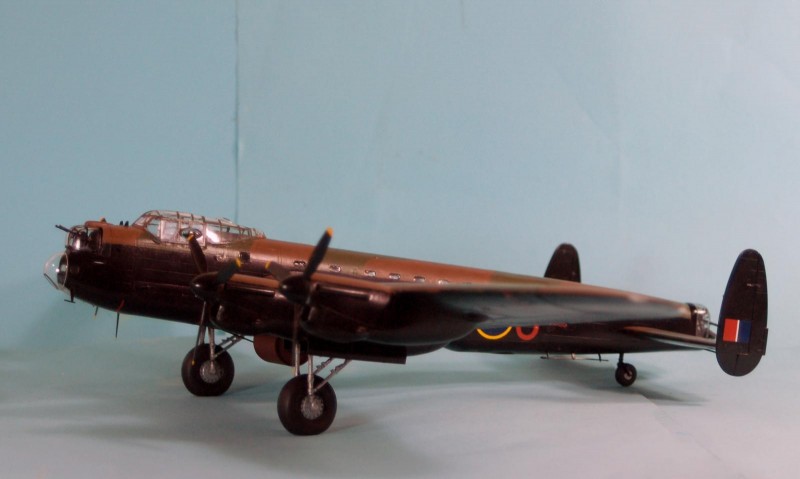
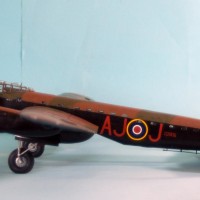
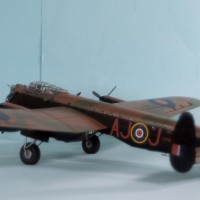
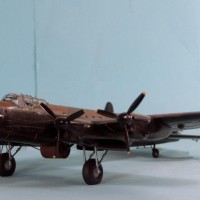
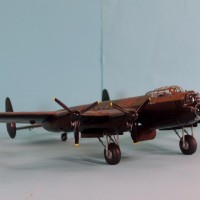
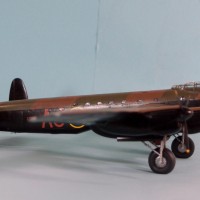
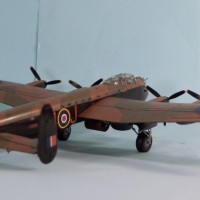

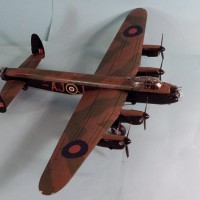
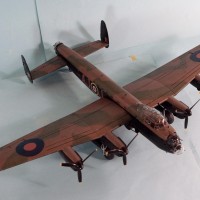
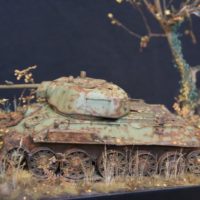
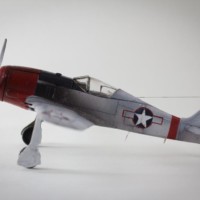
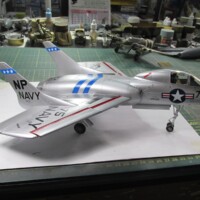
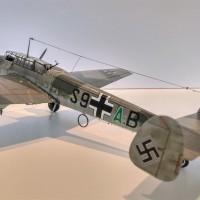
Well...considering your opening line said "...little needs to said about the Lancaster...", your narrative certainly put THAT statement to bed.
Seriously though, another nicely done build and presentation as always, TC.
LOL
Great story and build Tom. I've always wanted to build one but I'm not gonna pay that much money for 1:48 plastic...yet!
As always your narrative doesn’t disappoint. I remember watching the dam busters movie when I was kid and every time I see a Lancaster I’m reminded of it.
Great build my friend. Thanks for the in-depth backstory
Other than the portrait of Gibson, the movie is one of the best war movies ever for accuracy of the account.
Great article Tom
I have already two Tamiya s Lancaster kits
And also Belcher Bits set was purchased years ago
Hope to start mine next year.
Cheers
Nicely done Tom, the history lesson was spot on as well.
Tom, I just can't thank you enough. A completed build in the 'new' section of RAF100 and what a magnificent piece of work!
You may not agree, as you have written so much that is brilliant, but this may be my favourite historical post on iM. It has the lot! The way you have brought home the complex personality of Gibson is just perfect. The recounting of the Lancaster losses during Chastise (just a fraction of the approximately 3300 of the 7300 Lancs built that went down during the war); and the guilt felt by Barnes Wallis; and of course Gibson's death - the most famous of the Lancaster pilots eventually killed by one, encapsulates the horrific and immeasurably brave existence of bomber crews.
And then the build itself - I think you have captured something of the Lancaster that is difficult to put into words. I have seen the BoB memorial flight in action a few times now and the Lanc always brings a lump to the throat (probably only narrowly beaten by the traditional lone Spitfire ending to any Biggin Hill Airshow). However graceful in the air, the Lanc is not a thing of beauty for me (others will disagree) - I'd hazard a guess that is probably Britain's most devastating war machine. Your build just looks like it means business: gritty, functional and lethal. It is not an extravagant looking plane (however famous this particular aircraft and revolutionary (no pun) its weapon), but there is something in what you have built that to me captures exactly the character of a Lanc doing its work under those dark skies!
Congratulations Tom, I'm thrilled that you pulled this one off the shelf for RAF100, and for all of your entries in the previous builds section! A tough act to follow for sure!
I have to agree that Hollands book is one of the best books in the lot. Holland writes about each crew and their experiences while coming in and out of the mission and then he writes about what happened to many Germans and Russian Slave labors after the dams were breached. Over 700 hundred Russian women where electrocuted ...some of the returning Lancaster's where flying so low that the Germans were skipping shells off the water as they flew over the sea.
I've had the opportunity to see the Canadian War heritage Lancaster and it reminds me of a swan. A bit ugly or awkward on the ground but, once it gets into the air its a thing of beauty. It got a standing ovation at the airshow I attended while coming in on final and taxiing into the tarmac.
Great model and inspiration for pulling out the books and plastic TC.
Thanks for the great comments' guys. Every once in awhile, when you step to the plate, you get lucky and hit a home run.
Wow Tom- as usual, your narrative surrounding your build is fantastic- as much as the build! I was working up to finally build up my Tamiya Lancaster. I got the Dambuster version, (second hand from a contact in England years ago) but will be building it as a conventional MkIII instead.
I will be ordering that book you suggested.
I like to know the history behind my builds, and love reading about the people and events that shaped them. Never heard anything about Gibson like what you shared- the backstory supports the behaviour later in life.
Enjoyable as always.
Dan.
This is a very good article. I never realized the whole story behind Guy Gibson. Now it all makes sense...
The Lanc turned out good too.
But I'm a little confused by this posting. I was under the impression that we were all waiting to post our 100 Years of the RAF builds until October ? That's when the actual anniversary is.
Then I thought the builds were going to be posted in order by the decade they served in ... starting first with the planes that were in service until 1919.
Either way it's a good looking Lancaster.
AFAIK, they've just been getting put up, and the group build is over in October? I'm sure Paul can set us on the right path.
Good evening Gents (here in sunny Queensland at least) the initial date of the reveal was to be September 15th - Battle of Britain day. However, I feel that this deadline is a little sharp - especially given that some of us are building 12 spitfires (although I am sure you would make it with time to spare, Louis!) and others, for sundry reasons, haven't started some builds yet, and others again have hit the buffers for a while with 'real life' making its customary intrusions!
The inception of the RAF was on April 1st 1918. The 100th year obviously runs 1st April 2018 to end of March 2019. Apart from BoB day being apposite, I had 2 practical reasons for a set deadline. Firstly, I thought it important to get this GB done so that other GBs could be planned. Secondly, I wanted to do a decade by decade reveal across the month after the end date (hence the October date that has stuck in peoples heads). This would give the GB a unique character at its endpoint.
As the other GBs have come mostly to an end - fantastic Heinkel 111s notwithstanding - and since the Nose Art GB has been extended considerably, I don't see RAF100 getting in anyone's way. So I have been thinking about extending to mid-December - say the 15th. As a teacher in Aus the Summer holidays kick in about that time. In this way I would be reasonably free to orchestrate the phased final reveal - an RAF timeline in kits new and old - without work being an issue. This would culminate around the end of the calendar year - with those very organised people therefore able to plan their new year's builds free from RAF100 on iModeler!
I'd be interested in people's views - I will garner wider opinion elsewhere rather than clogging this thread up with those details, but currently I am very much inclined to extend that far.
If people want to show their hands or to wait for the 'big day' depends on their eagerness to post or happiness to wait. I know some have already put aside builds for the end date, which is great. The previous builds inventory has loads of pictures already. Personally I will hold on until the end date but I also think posts up to then can be of inspiration too!
Interested in both your views as fairly experienced figures on here.
A nice build an an excellent article on the raid and the men who carried it out. The completely sound thesis seems to be that not only does war break men, but men already broken make war.
Well done, Tom. Great history lesson, too!
As always, your work doesn't disappoint!
A fine history lesson and an equally fine build!